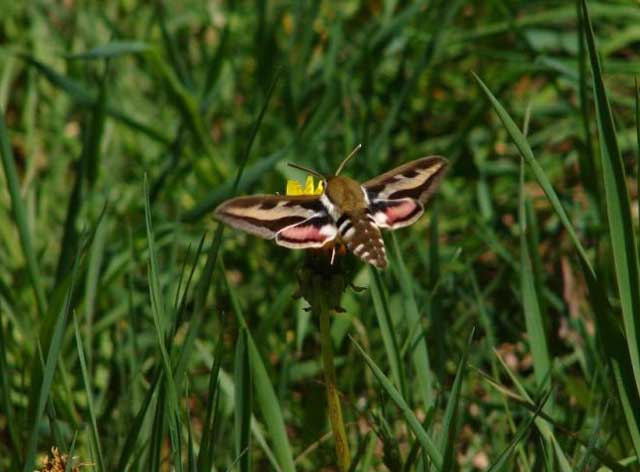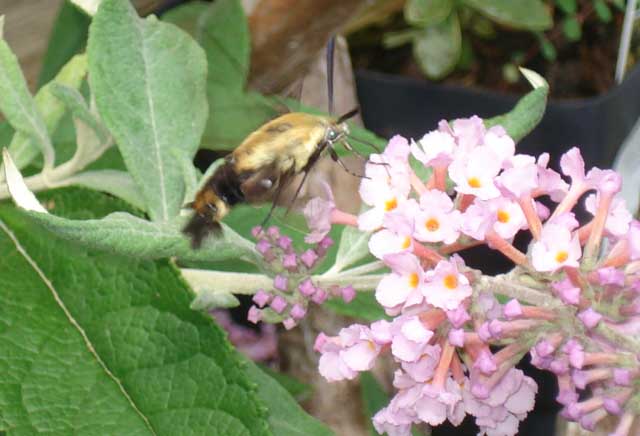Sphinginae subfamily
Sphingini tribe:
 |
Ceratomia amyntor
USGS,
the Elm Sphinx or Four-horned Sphinx:
The upperside of the forewing is brown with dark brown and white
markings including a white costal area near the wing base, dark
streaks along the veins, and a white spot in the cell. The upperside
of the hindwing is light brown and has a dark brown band along the
outer margin.
|
 |
Ceratomia catalpae
WO,
the Catalpa Sphinx:
This is generally a more southerly species, but it has been recorded
in Essex County and might be present in Berkshire County.
I saw them in great numbers in New Jersey. The larvae feed in large groups and are much more
spectacular than the moths.
Catalpa is the larval host.
Questionable! |
 |
Ceratomia undulosa
WO, Waved Sphinx:
Forewing pale brownish gray with wavy black
and white lines, black-outlined white cell spot.
Hindwing gray with diffuse darker bands.
Some individuals very dark, almost black, and others are light
yellowish brown.
|
 |
Dolba hyloeus
WO, the Pawpaw Sphinx:
The upperside of the forewing is dark brown with a dusting of white
scales. Some moths have patches of reddish or yellowish brown on the
wings. Larvae are not limited to pawpaw.
|
 |
Lapara bombycoides
USGS, Northern Pine Sphinx:
The upperside of the forewing is gray with heavy black bands. The
upperside of the hindwing is brownish gray with no markings.
The underside is rather plain
|
 |
Lapara coniferarum
USGS, Southern Pine Sphinx:
FW gray with two (sometimes one or
three) black dashes near wing center; other markings are usually
diffuse. HW uniform brown-gray.
Lacks more sharply contrasting black markings of fresh L. bombycoides. Extensive
reddish brown patch in median area near fw inner margin.
|
 | This species is probably present in Berkshire County.
The upperside of the forewing is gray-brown with wavy lines, black dashes, and one or
two small white spots near the center of the costa.
|
 |
Manduca jasminearum
WO the Ash Sphinx:
The upperside of forewing is gray to grayish brown with a black line
running from the middle of the costa to the middle of the outer
margin; the line may be broken near the margin. There is a splash of
brown around the cell spot. The upperside of the
hindwing is mostly black, with gray at the lower margin.
|
 |
This species is not recorded in Berkshire, but, if you
grow tomatoes, you have probably encountered it.
|
 |
This species is not officially recorded in Berkshire, but if you grow
tomatoes, you have probably encountered it.
Larvae get very large and can strip a tomato plant.
|

|
Sphinx canadensis
USGS,
Sphinx canadensis, the Canadian Sphinx,
The absence of the white spot on each forewing and the more brownish
coloration serve to separate canadensis from poecilus. The hindwing
fringe also tends to be white on poecilus
and checkered brownish on canadensis.
Larval hosts are white ash (Fraxinus americana) and blueberry
(Vaccinium).
|
 |
Sphinx chersis
USGS, the Northern Ash Sphinx or Great Ash Sphinx:
Larval hosts are ash, lilac, privet, cherry, and quaking aspen.
|
 | This species is not officially recorded, but I suspect it is
present. We have them on P.E.I., but I do not see them nearly as
frequently as I see the other Sphingidae.
|
 | This species is probably present in Berkshire County.
Colouration and markings are highly variable from one specimen to
another. The fringes on forewing are mostly
black with some white; those on the hindwing are mostly white with a
few black patches. |
 |
Sphinx kalmiae
USGS, the Laurel Sphinx:
The lower forewings are predominantly brownish-yellow with a fairly
wide dark bar along the inner margin. At rest the wings hug the
body, giving the moth a long slender look.
|
 |
Sphinx luscitiosa
USGS,
the Canadian Sphinx or Clemen's Sphinx:
FW upperside is yellowish gray in males; pale gray with
yellow tint in females. Dark border on outer margin widens
as it approaches inner margin. HW upperside is deep yellow in males,
pale yellow in females; both with wide black border.
|
 |
Sphinx poecila
USGS, the Poecila Sphinx:
If you have blueberries in the woods, then you probably have the Poecila Sphinx.
They are pretty common here on Prince Edward Island, but don't fly
too far south of Massachusetts, being replaced by
Sphinx gordius
in Connecticut.
|
Smerinthini Tribe:
 |
Amorpha juglandis
USGS,
the Walnut Sphinx:
Adults are highly variable; sometimes wings
may be all one color or may have several colors, ranging from pale to
dark brown, and may have white or pink tinge.
Patterns range from faint to pronounced.
This is the first Sphinx species I reared as a boy in New Jersey.
Female is different.
|
 |
Pachysphinx modesta
USGS
the Modest Sphinx or Poplar Sphinx:
This moth has a large, heavy body,
and females can be remarkably plump. Hindwings are often striking
in contrast to more sombre upperwings.
|
 |
Paonias astylus
WO, the Huckleberry Sphinx:
It is recorded for northeastern Massachusetts and western Connecticut
so may be present in Bershire.
It would be more common
in southeastern Massachusetts and is a relatively uncommon species.
|
 |
Paonias excaecata
USGS the Blinded Sphinx:
Named for the dull grey-blue spot in the hindwing, this moth has a
wide distribution and is probably common in Berkshire County.
I regularly see them on Prince Edward Island, and they are reported
as far south as Florida.
|
 |
Paonias myops
USGS/BH, the Small-eyed Sphinx:
Named for the small eye-spot in the hindwing, this moth has a wide
distribution and is probably common in Berkshire County.
I regularly see them on Prince Edward Island, and they are reported
as far south as Florida.
|
Paonias myops, Mt. Graylock, July 12, 2008, courtesy of Betsy Higgins.
 |
Smerinthus cerisyi
USGS, the Cerisyi's Sphinx: At my home in Montague, P.E.I., Canada, they are quite common and are very easy to rear.
Lower half of light coloured, forewing apical "c" does not return to outer margin in cerisy, but does in jamaicensis.
|
 |
Smerinthus jamaicensis
USGS, the Twin-spotted Sphinx:
Jamaicensis closely resembles cerisyi, but jamaicensis is much
smaller with larger blue patches on more vibrant and deeper purple in
the lower wings. Look for dark half moon, inwardly lined with white
at the fw apex.
|
Macroglossinae subfamily
Dilophonotini tribe:
See Hemaris comparison to help distinguish
the next three species.
 |
Hemaris thysbe
WO/KP, the Hummingbird Clearwing:
It is not difficult to see why many gardeners would mistake an
Hemaris thysbe moth for a small hummingbird as it hovers,
sipping nectar from flowers through a long feeding tube.
|
Hemaris thysbe, Florida, nectaring on swamp azalea, June 8, 2014, Karl Piela
 |
Hemaris gracilis
WO/KP
Slender Clearwing or Graceful Clearwing:
Gracilis is distinguished from similar species by pair of red-brown
bands on sides of thorax, varying from green to yellow-green
dorsally and sometimes brown with white below. Abdomen is red. Wings
are transparent with reddish brown borders.
|
Hemaris gracilis, Florida, nectaring on swamp azalea, June 8, 2014, Karl Piela
 |
Hemaris diffinis
USGS/RR/KP the Snowberry Clearwing or Bumblebee
Moth Note black on abdomen.
|
Hemaris diffinis, Windy Hill Farm, Stockbridge, September 2, 2012, Rick Riccitelli.
Hemaris diffinis, Florida, nectaring on swamp azalea, June 8, 2014, Karl Piela
Philampelini tribe:
 |
Eumorpha achemon WO, the Achemon Sphinx:
This moth is not officially reported for Berkshire,
but it is fairly often reported
along the coast from southern New Jersey
to central Maine.
Note the differences between this moth and the Pandorus Sphinx.
|
 |
Eumorpha pandorus WO, the Pandorus Sphinx:
If you have Grape or Virginia Creeper nearby, then you probably have
this species.
I often get asked to identify larvae from areas where they have not
previously been reported.
It is confirmed in Worcester Co. to the east. |
Macroglossini tribe:
 |
Amphion floridensis
WO/KP, the Nessus Sphinix:
If you have Virginia Creeper, you
probably have the Nessus Sphinx. Two bright, distinct, narrow
yellow bands are often visible on the abdomen.
|
Amphion floridensis, Florida, nectaring on swamp azalea, June 8, 2014, Karl Piela
 |
The lower wings of this hawkmoth are a solid brownish-orange,
matching the body colour.
You will often see this species listed as Darapsa pholus,
especially in older literature.
|
 |
Darapsa myron
USGS, Virginia Creeper Sphinx; Grapevine Sphinx:
FW dark brown to pale yellowish gray, with an olive tint
(often quite green).
On the costal margin there is a dark rectangular patch, although this
may be reduced or absent. HW upperside pale orange.
|
 |
If you have hydrangea growing near a stream, then you may have the
Hydrangea Sphinx. It has not been widely reported, however, and
probably is uncommon.
|
 |
Deidamia inscriptum
USGS,
the Lettered Sphinx:
Fw outer margin deeply scalloped.
Light brown with dark brown markings.
There is a small black and white spot near the tip.
The upperside of the hindwing is orange-brown with a dark brown outer
margin and median line.
|
 |
Hyles gallii
USGS/DS, the Bedstraw
Hawk Moth
or Gallium Sphinx:
Note thick, irregular, creamy transverse line on forewings and the
absence of thin white lines on forewings and thorax.
|
Hyles gallii, May 28, 2006, courtesy of Dave Small.
 |
Hyles lineata
USGS, the White-lined Sphinx:
Fw dark olive brown with paler brown along
costa and outer margin, narrow tan band running from wing tip
to base, and white streaks along the veins.
Hw black with reddish pink median band.
|
 |
Sphecodina abbottii
WO, Abbott's Sphinx:
Mimic bumblebees and make a buzzing sound when
feeding. The wing margins are scalloped. The upperside of the
forewing is dark brown with light brown bands and markings. The
upperside of the hindwing is yellow with a wide black outer margin.
|
|
|


